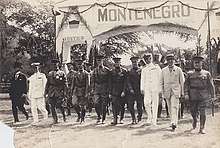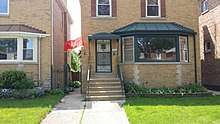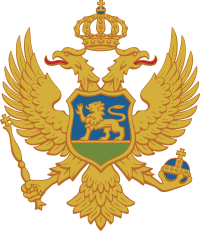Montenegrin Americans
Montenegrin Americans are Americans who are of Montenegrin origin. The figure includes all people affiliated with United States who claim Montenegrin ancestry, both those born in the country and naturalized citizens, as well as those with dual citizenship who affiliate themselves with both countries or cultures. The number of Montenegrin Americans in the United States is unknown, as the Montenegrin community has not been differentiated in the United States Censuses as different from closely related Serbian American and Yugoslav American groups; therefore Montenegrin Americans are likely to identify with those groups.
| Total population | |
|---|---|
| Unknown; 40,000 (2014 estimate)[1] | |
| Regions with significant populations | |
| California, Illinois, New York, Louisiana, Alaska | |
| Languages | |
| American English Montenegrin | |
| Religion | |
| Predominantly Eastern Orthodox | |
| Related ethnic groups | |
| Montenegrin Canadians, Yugoslav Americans other Slavic and European Americans |
History
Early period
At the end of the 19th and early 20th centuries, mass migration of Montenegrins into America occurred. It went in groups, but also individually. First of all, young people from the coastal part of Montenegro were leaving: Boka, Pastrovici, the surroundings of Budva, then from Crmnica, Katun nahija, Gragova, Krivosija, Vilusa, so that in a few years the departure would be extended to the region of Niksic, Bjelopavlici, Piva, Zabljak, Moraca and the whole northern part of Montenegro.
The Austro-Hungarian authorities then helped to get as many Montenegrins as possible, especially young men, to go to America to leave as few soldiers as possible in Montenegro who could go to war.
The number of emigrants has grown from year to year. According to the passport book, which was carefully conducted from 1864 to 1914 in the Kingdom of Montenegro, in the United States, according to Pavel Rovinski, there were 17 thousand young Montenegrins. This is stated in the "Glas Crnogorca", which was at that time in Cetinje, as well as in the "Slobodna Misao" newspaper in Niksic. Interesting is the fact that in 1903, in the course of five months, from the beginning of August to the end of December, 621 Montenegrins went to America. [2]
With the departure of young people through Atlantic ocean, spontaneously disappeared the first verses that best talked to the desire to get to the far rich country as soon as possible. Many Montenegrins sang a song: "Ameriko, rosno cvijeće/ nema toga ko te neće/ ni đeteta od tri ljeta/ niti starca od 100 ljeta…" Ili: "Ameriko zemljo kleta/ po tebi mi drago šeta/. Molim brata, molim kuma, /da mi zajme trista kruna/ da otidem u Čikago,/ pa da vidim moje drago/ kako radi i propada/ i daleko jade jada…" Ili: "Navijorče, vrći momke/ da s’ udaju Crnogorke…" "[2]

Communities
Today, these Montenegrins mainly live in the central and eastern United States, much of which is concentrated in New York City and Chicago, and to a lesser extent in Detroit, and recent arrivals from former Yugoslavia in the Los Angeles area.

Montenegrin Americans are found throughout the state of Alaska. About a quarter of all known Montenegrin Americans live in Anchorage. Their presence in Alaska dates back to the gold rushes of the early 20th century. A short-lived newspaper entitled Servian Montenegrin was established at the beginning of 1905 in the town of Douglas, near Juneau.[3]
| Part of a series on |
| Montenegrins |
|---|
 |
| By region or country |
| Recognized populations |
|
Montenegro Serbia Bosnia and Herzegovina Croatia North Macedonia Kosovo Albania |
| Diaspora |
|
Europe · Austria · Denmark France · Germany Italy · Luxembourg Russia · Slovenia Sweden · Switzerland United Kingdom |
|
North America United States · Canada · Mexico |
|
South America Argentina · Chile Bolivia · Brazil · Colombia |
|
Oceania Australia · New Zealand |
| Culture |
|
Literature · Music · Art · Cinema Cuisine · Dress · Sport |
| Religion |
|
Catholicism Islam |
| Language and dialects |
| Montenegrin · Serbian |
| History |
|
History of Montenegro Rulers |
Notable people
| Lists of Americans |
|---|
| By U.S. state |
| By ethnicity or nationality |
|
|
|
|
|
|
|
|
|
Arts and entertainment
- Marina Abramović, performance artist[4]
Literature
- Elijah Monte Radlovic
- Nikola Petanović, writer and philosopher
Film
- Ivan Kraljevic, film director
- Milla Jovovich, actress
Politics
- Mark Brnovich, Arizona Attorney General
- Michael Anthony Stepovich, former governor of Alaska Territory, 1957-1958 (last appointed governor before statehood).
- John Butrovich, former Alaska State Senator
- John Dapcevich, former Mayor of Sitka, Alaska
- Marko Dapcevich, most recent former Mayor of Sitka, Alaska
- Susan Marie Brnovich, Arizona Superior Court Judge
- George Perazich, humanitarian
Sports
- Nicholas Delpopolo, Olympic athlete - judo
- Gregg Popovich, basketball coach
- Mirsad Huseinovic, soccer player
- Novo Bojovic, football player
- Žarko Čabarkapa, NBA player
- Predrag Drobnjak, NBA player
- Slavko Vraneš, NBA player
- Nikola Mirotić, NBA player
- Nikola Peković, NBA player
- Nikola Vučević, NBA player
- Halil Kanacević, basketball player in Europe
Fictional
Other
- Butch Verich, commander
References
- "Širom svijeta pola miliona Crnogoraca". Rtcg.me. Retrieved 2 January 2018.
- "Iz istorije crnogorskog iseljeništva". Montenegrina.net. Retrieved 25 May 2017.
- Nicolson, Mary C.; Slemmons, Mary Anne (1998). Alaska Newspapers On Microfilm, 1866-1998. Fairbanks/Juneau: University of Alaska Fairbanks/Alaska State Library. pp. 63–64.
- "Marina Abramović uspomena na oca Crnogorca je slika sa guslama". CdM.me. Retrieved 2 January 2018.